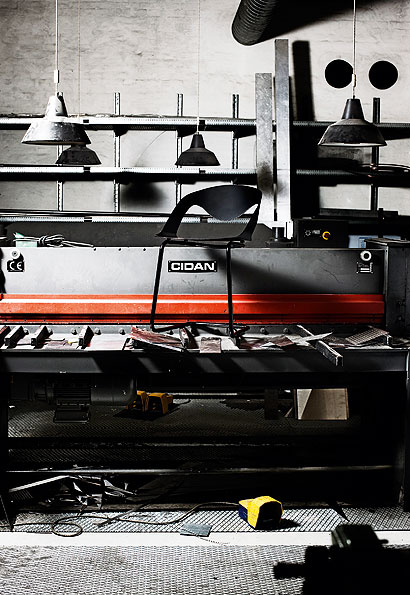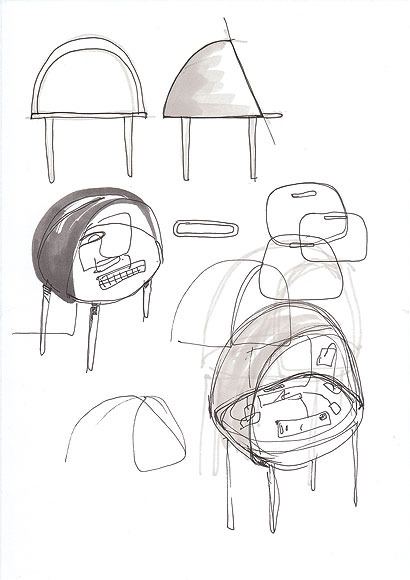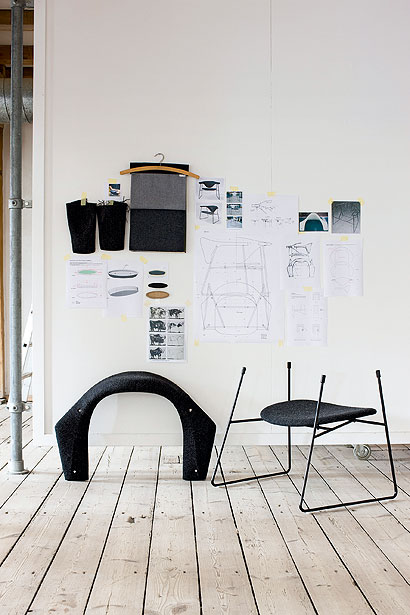|
Attention to detail from the fastidious Danish-Italian design duo Stine Gam and Enrico Fratesi are control freaks. Last summer the Danish-Italian furniture design duo, who go under the name GamFratesi, waited a whole day for exactly the right light to take a product shot of their new desk. “The photograph was inspired by the Danish painter Vilhelm Hammershoi – it’s about this light and this Nordic atmosphere that we had fallen in love with. So we were waiting for hours for the right light this rainy day,” says Fratesi. The first time I call them, instead of a ringing sound I’m played the original 1970s version of Three is a Magic Number. It’s no wonder that they’re trying to micromanage the photographer who’s taking their portrait. We’re in their Copenhagen studio, and the pair are conversing in hushed Italian, discussing the angle of the camera and whether or not it will portray them and their work in the right way. They like things just so. GamFratesi has built a reputation for making furniture with a lot of personality. The charmingly clumsy Cartoon chair for Swedese is a modern-day classic. And the duo’s most recent work, the shy-looking Rewrite desk, which comes with its own protective hood, is another very particular creation. The duo’s work continues the Scandinavian aesthetic of Danish masters such as Hans Wegner and Arne Jacobsen, but adds another dimension. “We have this strict Scandinavian approach to the craft and these minimalist structures but there is often an emotional concept behind it. There is always something which is trying to bring the piece out of balance a little, and we spend a lot of time thinking what that is.” Last autumn they won the prestigious Danish furniture design award Walk the Plank, which confirmed them as Denmark’s most promising new furniture designers. And 2010 looks like the year when they will capitalise on that honour. They are launching a new chair, Chameleon, with Danish manufacturer Erik Jørgensen at the Stockholm furniture fair. They hope to launch the Rewrite desk and the Not Bamboo light – made of oak tubes slotted together so that they, accidentally, look like bamboo – at the Milan furniture fair in April. But they can’t name the manufacturer. And there’s a collection of small objects due for release this autumn that they can’t reveal anything about.
The 3mm chair, 2009, inspired by folding paper (image: Tuala Hjarnø) The paradox at the heart of GamFratesi’s work is that the pair’s meticulous, controlling nature yields such relaxed-looking products. There is something childlike, even naive, about the pieces. The Cartoon chair is the best example of this aesthetic. It is instantly likeable, perhaps because it has an anthropomorphic quality with its face-like back rest. The clumsiness of the form becomes a virtue. “The first concept for a piece can be very spontaneous,” says Gam, trying to explain this. “It can be a reflection of light or something very abstract like that, and that can happen anywhere. We also like to draw and play with drawing a lot.” Indeed, it feels as if the pieces have jumped, cartoon-like, from the paper and into real life, wobbles and all. This also brings a simplicity and minimalism to the finished work – all joints are beautifully crafted, and sometimes it can be difficult to work out how a piece holds together, as with the Meduse table for Casamania. Stine Gam, 34, and Enrico Fratesi, 31, met while studying architecture in Ferrara, Italy, followed by some time at Århus university, rooting both of them in each other’s cultures. The move from architecture to furniture design came late in their studies, when they had to pick a specialism. “But we have this pace which is more architectural, in how we analyse a product’s use and how we bring inspiration to a project,” says Gam. “I have a feeling that it’s very different from the way an industrial designer works,” says Fratesi. Since 2006 they have been based in Copenhagen, but spend a lot of time in Italy, where they can work with skilled craftsmen on refining the details of their products. In some ways, one of their biggest achievements has been to secure a place at Statens Verksteder for Kunst og Handverk, where we meet. It’s a government-funded initiative for professional craftsmen and artists, offering studio space and equipment free of charge. The beautiful 18th-century warehouse contains all the machinery they might need, from metal workshops to textile studios. It’s an opportunity not many designers get, and without it it’s unlikely they would have been able to develop their work in the way they have. GamFratesi belongs to the design world’s MTV Unplugged generation. Its work is based on the real, the analogue, the literal craft of the hand. The pair detests working on computers and does it only if really necessary, which is only for the technical drawings handed over to the manufacturer. “We hate it, both of us!” says Fratesi passionately. “You can click on the computer so many times and create a different chair in Autocad, but you actually need to see it in three dimensions and in real light to fully understand it.” Instead, drawing plays a big part in the creative process. These are turned into small-scale models that are then painstakingly made into the finished piece. “When we show a product to a manufacturer we are quite far down the line in the process, as we always present a prototype, not just a drawing – so the finished product often stays very true to the original,” says Gam. “We go very deep into details in our prototypes – how to finish the fabric, how to finish the wood – so it’s not so easy to change.”
Cartoon chair for Swedese, 2008 (image: Tuala Hjarnø) This sounds like GamFratesi’s controlling impulse again, presenting a manufacturer with a fait accompli instead of approaching it as a potential compromise based on economic and technical limitations. For example, its hand-stitched Masculo chair for Gubi cost much more than the Danish manufacturer had intended. But GamFratesi has a knack of engineering situations to get what it wants. “Yes, I suppose there is a little of that in us,” admits Fratesi. It’s a mark of how much they care. And this interview is no exception. They are both focusing on me with feverish intensity, so that it feels more like an exam than an interview. It’s a little unnerving. This cold January day Copenhagen is still plastered with the leftover posters for the climate change conference that yielded few results. If anything, that conference failed because our economic and environmental concerns seem to be at odds: the imperatives of growth, speed and novelty don’t lend themselves to a healthy climate. In that light there is something pleasing about GamFratesi’s work. It’s intrinsically slow, a slowness that sticks out in a world obsessed with fast outcomes. Waiting for the right light for hours, painstakingly crafting prototypes, drawing by hand. Even the way they talk, carefully weighing each word before delivering a sentence, embraces slowness. There is definitely a lesson to be learned from the control and the dedication GamFratesi employs in its design work. “We take it easy, but we work hard and we make sure that we are always happy with what we do,” says Fratesi.
Sketches of the Rewrite Desk (image: Gamfratesi)
The Masculo chair for Gubi, 2008, in pieces (image: Tuala Hjarnø) |
Portrait Martin Magntorn
Words Johanna Agerman |
|
|
||
|
An installation of Meduse tables for Casanova, 2009 (image: Tuala Hjarnø) |
||























